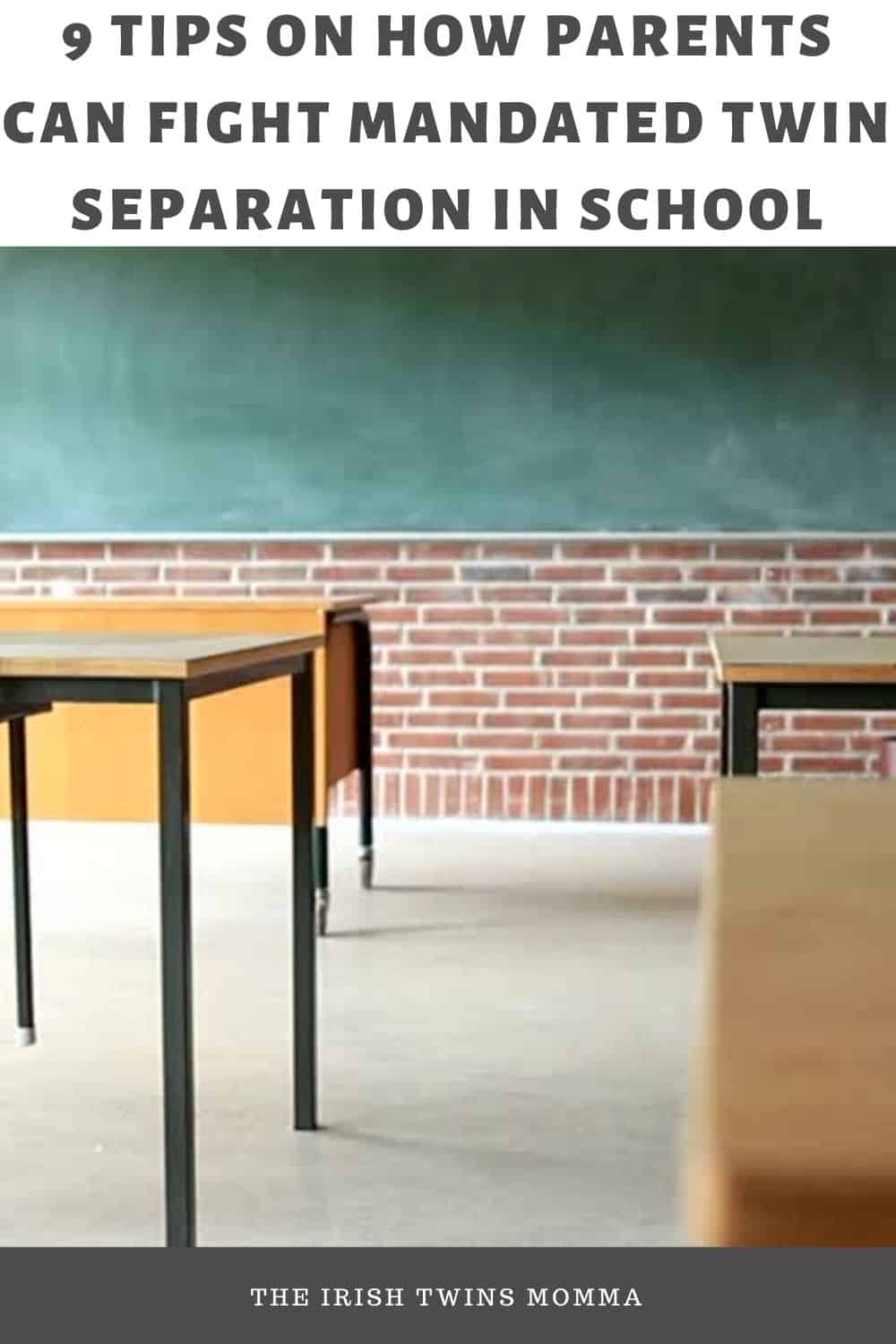This post contains affiliate links. If you click and buy, I may make a commission, at no cost to you. See my disclosure policy for more information.
Parents of twins face many challenges. With twin babies, there are sleepless nights, dozens of diapers, and round-the-clock feedings. But as young twins prepare to start school, parents may find themselves facing a bigger problem: a school that insists on separating their children into separate classes, and children who are devastated that they can’t be together. What should parents do? It’s one of the biggest dilemmas faced by parents of twins.
Whether twins belong together in the same classroom or not is a tricky issue when they are starting Kindergarten. The answer is different for every set of twins, and the right decision could change from year to year. There are many reasons to recommend keeping twins together and just as many in favor of separate classes for twins. But unfortunately, in many cases, twin families don’t have the right to decide at all. Instead, the school chooses for them. And, in many cases, the school’s decision is to separate twins based on misguided perceptions, antiquated information, or just plain convenience.
In some states, legislation protects twin families’ rights to have input into their children’s educational situation. Even the Supreme Court has added substantial constitutional rights for parents and children. Congress overcame its initial hesitations to pass sweeping education reforms like the1964 Civil Rights Act, the Education for All Handicapped Children Act, the No Child Left Behind Act, and numerous other landmark policies to give rights to parents.
What should parents do when they encounter opposition to their wishes? Here are some suggestions.
Steps to Take If You Disagree With Your Twins Being Separated in Class
What can you do if you don’t agree with your school’s policy about classroom placement of multiples?
1. Find out if the law is on your side. Perhaps your state has already enacted a Twins Law. Visit the Twins Law website for updates in your state for more information.
2. Ask to see any existing policy in writing. Very few school administrations have a written guideline on record. In most cases, it’s simply “the way it’s been done.”
3. Do some research to support your case. Some school administrators are simply not aware of the body of evidence related to this issue and may be willing to reconsider their position based on recent research. Compile materials from Multiples of America (also called National Organization of Mothers of Twins Clubs), websites such as this one, and articles from publications such as Twins Magazine. Further resources are listed below. If you make a sound case, your school’s principal may back down.
4. Seek opinions from the professionals that know your children best. Consult your pediatrician for a medical perspective, and also talk to caregivers that interact with your multiples in a daycare, school, or playgroup setting. Enlist the support of your children’s present teachers, if applicable. Ask them to share their input about your children’s’ individual personalities and educational needs, as well as describe the dynamic of their twin relationship. Ask them to write a letter to support your case.
5. Keep a paper trail or a journal. Record in detail any incidences or anecdotes that support your case. For example, if your twins become agitated or distracted when separated, or if one tends to be more communicative.
6. File a formal letter with the school’s principal or an administrator. Your letter should cover several bases: your personal statement, psychological effects of twin separation, legal issues that are on your side (such as the proposed laws in your state and legislation in other states), academic performance, and lots of input from objective, outside sources, such as all the examples above. Your goal is to inform about the research and legislation that supports keeping twins together when requested by the parents, and why you feel it is in your children’s’ best interest to be together. Prove that they are (or will be) successful when they are together, and make a case that it would be harmful if they were separated. Include references both to emotional strain and the subsequent impact on academic performance.
7. If your principal won’t relent, go straight to the school board and the school administration (superintendent). Send letters (or emails), with all the supporting documentation, and follow up with phone calls until you get an answer.
8. Finally, don’t be afraid to make waves. Many parents of multiples feel intimidated by school administrators and fear repercussions if they challenge their authority. You are your children’s best advocates, and you have to do what’s best for them.
9. Or course, maintain a professional, courteous tone throughout all interaction in order to not anger the school officials (who you’ll have to deal with for several more years while your twins are in the school system) Present yourself as a “partner” rather than an antagonist or demanding parent, and reinforce that you all have the same goal – school success for your children.
Sincerely,

It’s vital that you do your research so that you are well prepared to defend your claim that it is in your twins’ best interest to be kept together. Here are some research sources to support your case:
Twins: In Defense of Togetherness
Other Parents Stories: Twin University
Breaking the Barriers: The Secret to Controlling Your Twins School Placement
Study by CSUN Prof Challenges Practice of Separating Twins in Kindergarten


Leave a Reply